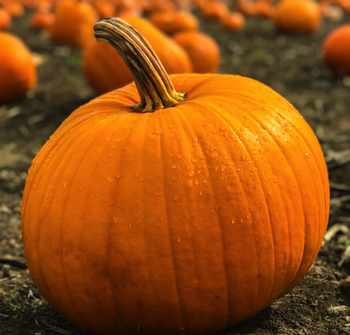Pumpkin
-
Scientific NameCucurbita pepo
-
General InformationPumpkin is a winter squash that grows from a flower. It is a fruit, but it is usually prepared as a vegetable. The plant has male and female flowers. Pumpkins need lots of growing space and may be trellised.
 Photo: Marius Ciocirlan, Unsplash
Photo: Marius Ciocirlan, Unsplash -
When to Plant
Plant seeds indoors beginning in March. Plant starts and/or seeds outdoors mid-April to mid-June. For best results, wait until soil is warmed up in the spring and night temperatures are above 55 degrees.
-
Planting
Pumpkins do not do well in high heat and humidity. Choose a sunny spot with at least six hours of full sun. Directly seed one inch deep, in a four to six inch flat-topped mound, using three seeds per mound. When direct seeding or planting starts, irrigate beds deeply prior to planting. Keep beds moist during seed germination. When plants are three inches tall, thin to one plant per mound.
-
Soil Requirements
Does well on a range of soil types, but grows best on well-drained, sandy loam soil with pH 6.0 to 6.8.
-
Water Requirements
Prior to planting, apply water to one foot depth to insure deep rooting. Regularly replace water lost in the top one to two inches of soil. Even watering is key. Like tomatoes, pumpkin is susceptible to blossom end rot caused by uneven watering that leads to calcium deficiency. In cooler microclimates, depending upon soil type and weather, cease irrigation in mid-August to hasten ripening.
-
Fertilizing
Pumpkins prefer to grow in soil rich in organic matter, so add plenty of compost or composted manure before planting. If fertilizer is needed, apply an organic vegetable fertilizer blend with a nutrient analysis of 10-10-5, 12-12-12, or similar numbers. Follow directions on package.
-
Pollination
Not self-pollinating. Pumpkin plants have male and female flowers on the same plant. Male pollen must be transferred to female flower for pollination to occur. Honeybees are the principal pollinators. Hand pollination is an option in areas with few honeybees.
-
Harvesting
If planning to store pumpkins, leave them on the vine until they mature. Mature pumpkins have hard outer shells and are generally even-colored. If the stems are fleshy, the fruit is immature. To harvest, use a sharp knife to cut the stem of the pumpkin, leaving three to five inches of the stem attached to the pumpkin. Do not pick up pumpkins by the stem. Typically a large fruited pumpkin plant will produce only two pumpkins per vine, while a small-fruited pumpkin will produce eight to 10 fruits.
-
Storage
Store in a dry, fairly cool location (ideally 55 to 59ºF at 50 to 70% relative humidity). Under these conditions, if you harvest mature, not over-ripe fruit, you can expect a storage life of up to 60 days. Pumpkins cannot be stored beyond 90 days even in ideal storage conditions. Once the shell has been cut, cooking/baking pumpkins must be placed in an airtight container and refrigerated. When your jack-o-lantern has served its usefulness or you have completed your harvest, compost pumpkin vines and shells or place them in the green bin. Do not reuse Jack-o-lanterns in a recipe. Carved pumpkins are a perfect place for bacteria to grow and the varieties grown for jack-o-lanterns are not the best varieties for eating.
-
Good Varieties for Marin
Cooking variety: 'Small Sugar'
Jack-o’-lanterns: 'Howden' 'Connecticut Field Pumpkin' 'Spirit'
Mildew resistant: ‘Charisma’ -
Helpful Tips
Hand pollination is an option in areas with few honeybees. Plant pollinator flowers nearby to encourage bees. Pumpkins are usually vine forming. Make sure you have plenty of room (at least eight feet) for plant to expand. Try a bush variety if limited in space. Bush varieties do not produce as many fruits.
-
Common Problems
Powdery mildew – causes include plants spaced too close together and overhead watering.
Misshapen fruit and poor yield - cause is few honeybees present and only partial pollination occurs. Hand pollination of female flowers with pollen from male flowers will increase yield.
Spacing problems – choose short vine varieties such as ‘Spirit’ and/or contain the plant by pinching out the growing tips after a vine has set a few fruits.
-
Pests- Diseases & More

